1ST TERM
1ST TERM
SCHEME OF WORK:
1. Revision of first year work
2. Signs of puberty: (a) Meaning of puberty and menstruation. (b)Body changes in males and females. (c)Menstrual cycle. (d) Menstrual hygiene.
3. Hygiene and Puberty: (a) Causes and prevention of body odour. (b)Importance of personal hygiene.
4. Adolescence (a) Meaning and characteristics of adolescence. (b) Special needs and challenges of the adolescence.
5. Sexuality: (a) meaning and expressions of sexuality. (b) Sources and utilization of sexuality related information e.g. internet and home videos.
6. Sexual Transmitted Disease (STDs) and HIV/AIDS: STD/STI, HIV/AIDS- meaning, types, causes, prevention. Management, care and support for infected persons. (b)Consequences of self-medication.
7. The impact of family values on life styles: Family values and life style- (i) Meaning of values and life styles, (ii) Types of values and life styles.
8. The impact of family values on life styles: (iii) importance of value systems and life styles (iv) factors that influence individual, family, and societal values and life styles.
9. Revision.
1. Revision of first year work
2. Signs of puberty: (a) Meaning of puberty and menstruation. (b)Body changes in males and females. (c)Menstrual cycle. (d) Menstrual hygiene.
3. Hygiene and Puberty: (a) Causes and prevention of body odour. (b)Importance of personal hygiene.
4. Adolescence (a) Meaning and characteristics of adolescence. (b) Special needs and challenges of the adolescence.
5. Sexuality: (a) meaning and expressions of sexuality. (b) Sources and utilization of sexuality related information e.g. internet and home videos.
6. Sexual Transmitted Disease (STDs) and HIV/AIDS: STD/STI, HIV/AIDS- meaning, types, causes, prevention. Management, care and support for infected persons. (b)Consequences of self-medication.
7. The impact of family values on life styles: Family values and life style- (i) Meaning of values and life styles, (ii) Types of values and life styles.
8. The impact of family values on life styles: (iii) importance of value systems and life styles (iv) factors that influence individual, family, and societal values and life styles.
9. Revision.
Week 1
TOPIC: SIGNS OF PUBERTY
CONTENT: 1. Meaning of Puberty and Menstruation, Body changes in male and female.
2. Menstrual cycle and menstrual hygiene.
Sub-Topic 1: Meaning of Puberty and Menstruation, Body changes in male and female.
Meaning:
Puberty is the short span of time which marks the beginning of sexual maturation. The period differs between boys and girls. Boys reach puberty at age of fourteen years while girls reach it at about twelve years of age.
Menstruation is the monthly flow of blood from the womb, through the vagina which occurs in every woman of child bearing age. This period is called menstrual period which may last 3-5 days, it also differs from one person to another. Once a girl starts menstruating she becomes a woman. She can then become pregnant and have a baby, if she has sexual relationship with a man.
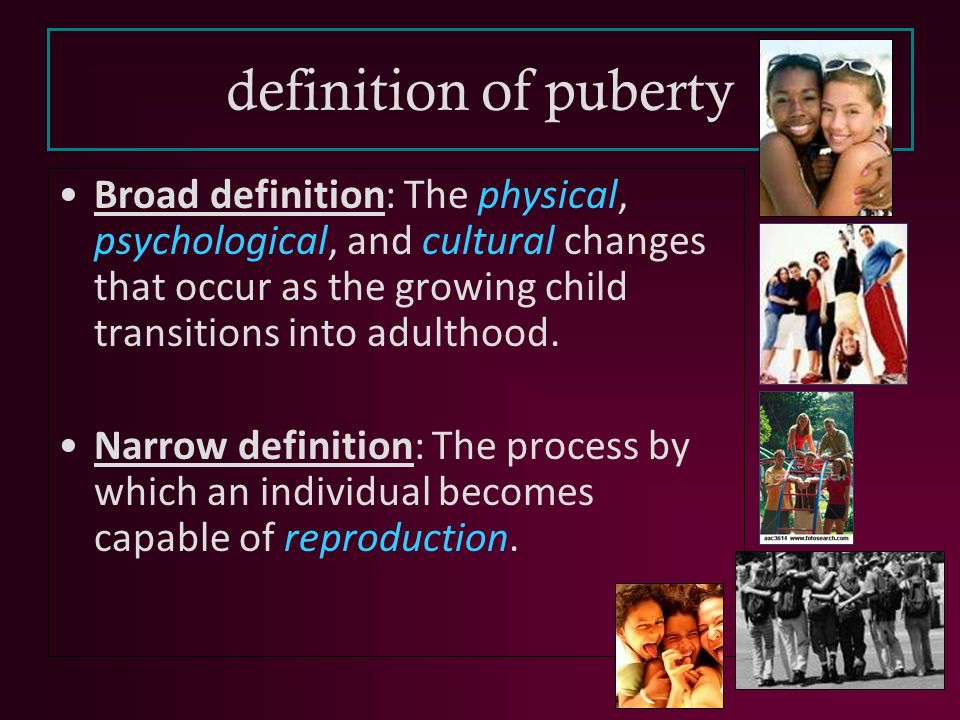
Body changes in males (boys)
1. Boys voice breaks and becomes deeper
2. Hair starts to grow on and around the genital organs, under the armpits and beard around the jaw.
3. Sex organs develop. Sex gland called testicles produces spermatozoa or sperm.
4. The body muscles develop, which make them become mature in appearance.
5. Rapid growth in height and size
6. Development of pimples.
7. Shoulder and chest grow bigger.
8. Boys experience wet dreams.
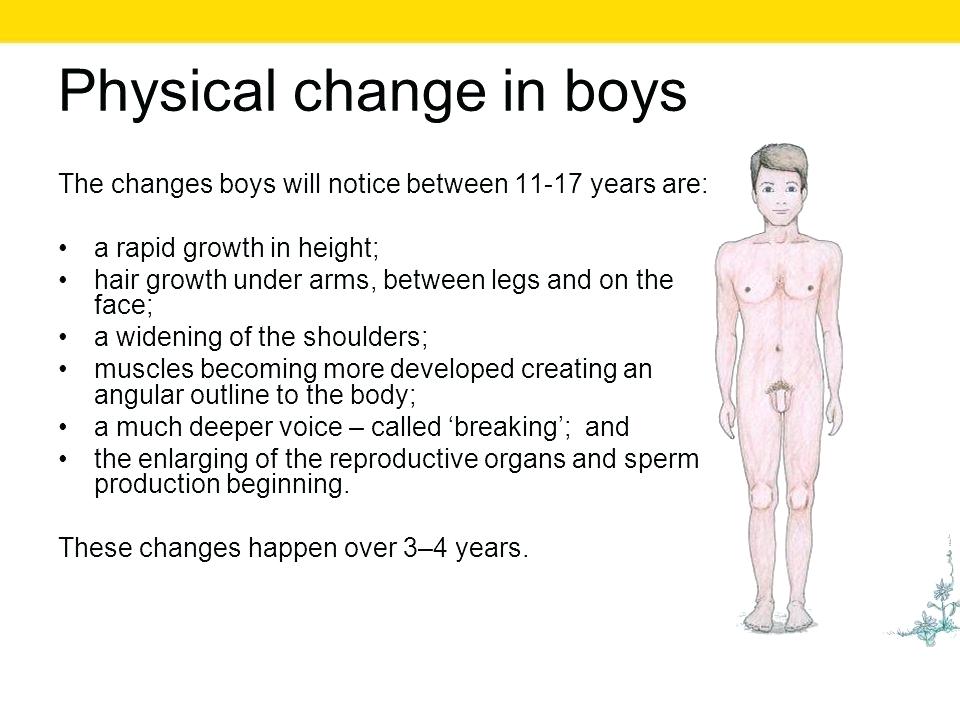
Body changes in females (girls)
1. The breasts develop and nipples grow larger.
2. General body changes such as hips become bigger, skin changes (appearance of pimples on the face)
3. The reproductive system begins to grow and develop.
4. Menstruation starts.
5. Hair begins to grow in the private parts, armpits and other parts of the body.
6. Rapid growth in height and size.
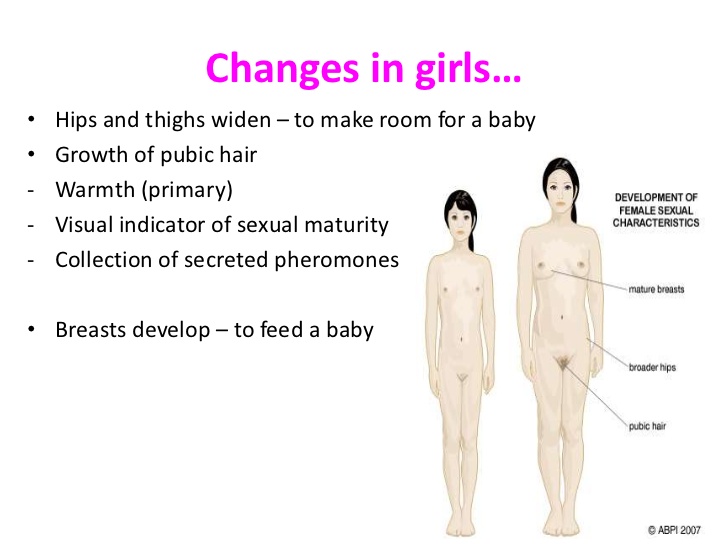
Evaluation:
1. What is puberty?
2. What is menstruation?
3. Mention four changes that occur in a boy’s body during puberty.
4. State four changes that occur in a girl body during puberty stage.
Reading assignment:
Popoola O.O. Home Economics New Concepts for JSS Book 2 Pages 152-153
Sub-Topic 2: Menstrual cycle and menstrual hygiene.
Menstruation takes place after about every 25-30 days. The number of days before the next period is called menstrual cycle. This cycle differs from one person to another. An individual may experience some discomfort or pain before the period begins. Pain –killing tablets prescribed by the doctor can be taken to relieve the pain.

Menstrual hygiene
The blood that flows during menstruation can produce a very bad odour if a person fails to keep her body clean. Therefore, menstrual hygiene is the cleanliness of the body during menstruation.

The following hygiene practices are very important during menstruation.
1. Have frequent baths during menstruation at least twice a day. Have local bath of the vulva area each time you change your pad if possible
2. Wrap the soiled pad in an old newspaper. Put in a refuse bin or pit toilet or burn it. Do not throw the used pad into the water system or water closet toilet.
3. Change the sanitary pad as often as three times a day to prevent bad odour.
4. Use good absorbent sanitary pads or towel and pants. These will prevent your clothes from being stained by blood.
5. Wash your hands with soap and water after each change of pad.
6. Menstruation is not a disease. Therefore, carry about your normal activities during your menstrual period.
7. Use a little perfumes and deodorants to prevent bad odour.
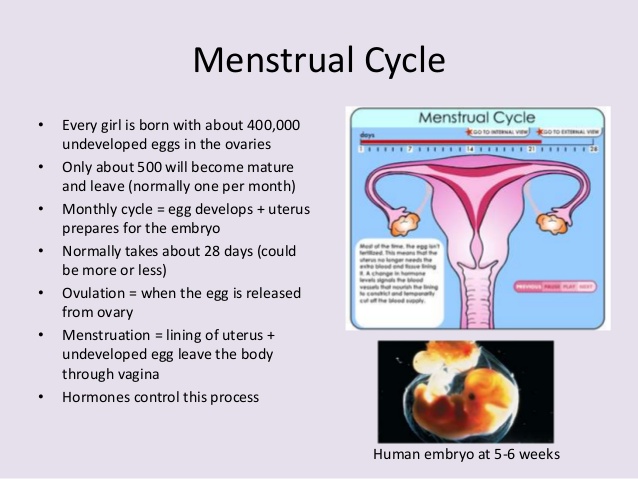
Evaluation:
1. What is menstrual hygiene
2. Outline four necessary hygiene practices during menstruation.
Activity:
Cut out picture or diagrams of different types of sanitary that can be used during menstruation
Reading assignment:
Popoola O.O. Home Economics New Concepts for JSS Book 2 Page 154
ASSIGNMENT
Popoola O.O. Workbook on Home Economics New Concepts for JSS Book 2 Unit 17 Page 38
CONTENT: 1. Meaning of Puberty and Menstruation, Body changes in male and female.
2. Menstrual cycle and menstrual hygiene.
Sub-Topic 1: Meaning of Puberty and Menstruation, Body changes in male and female.
Meaning:
Puberty is the short span of time which marks the beginning of sexual maturation. The period differs between boys and girls. Boys reach puberty at age of fourteen years while girls reach it at about twelve years of age.
Menstruation is the monthly flow of blood from the womb, through the vagina which occurs in every woman of child bearing age. This period is called menstrual period which may last 3-5 days, it also differs from one person to another. Once a girl starts menstruating she becomes a woman. She can then become pregnant and have a baby, if she has sexual relationship with a man.

Body changes in males (boys)
1. Boys voice breaks and becomes deeper
2. Hair starts to grow on and around the genital organs, under the armpits and beard around the jaw.
3. Sex organs develop. Sex gland called testicles produces spermatozoa or sperm.
4. The body muscles develop, which make them become mature in appearance.
5. Rapid growth in height and size
6. Development of pimples.
7. Shoulder and chest grow bigger.
8. Boys experience wet dreams.

Body changes in females (girls)
1. The breasts develop and nipples grow larger.
2. General body changes such as hips become bigger, skin changes (appearance of pimples on the face)
3. The reproductive system begins to grow and develop.
4. Menstruation starts.
5. Hair begins to grow in the private parts, armpits and other parts of the body.
6. Rapid growth in height and size.

Evaluation:
1. What is puberty?
2. What is menstruation?
3. Mention four changes that occur in a boy’s body during puberty.
4. State four changes that occur in a girl body during puberty stage.
Reading assignment:
Popoola O.O. Home Economics New Concepts for JSS Book 2 Pages 152-153
Sub-Topic 2: Menstrual cycle and menstrual hygiene.
Menstruation takes place after about every 25-30 days. The number of days before the next period is called menstrual cycle. This cycle differs from one person to another. An individual may experience some discomfort or pain before the period begins. Pain –killing tablets prescribed by the doctor can be taken to relieve the pain.

Menstrual hygiene
The blood that flows during menstruation can produce a very bad odour if a person fails to keep her body clean. Therefore, menstrual hygiene is the cleanliness of the body during menstruation.

The following hygiene practices are very important during menstruation.
1. Have frequent baths during menstruation at least twice a day. Have local bath of the vulva area each time you change your pad if possible
2. Wrap the soiled pad in an old newspaper. Put in a refuse bin or pit toilet or burn it. Do not throw the used pad into the water system or water closet toilet.
3. Change the sanitary pad as often as three times a day to prevent bad odour.
4. Use good absorbent sanitary pads or towel and pants. These will prevent your clothes from being stained by blood.
5. Wash your hands with soap and water after each change of pad.
6. Menstruation is not a disease. Therefore, carry about your normal activities during your menstrual period.
7. Use a little perfumes and deodorants to prevent bad odour.

Evaluation:
1. What is menstrual hygiene
2. Outline four necessary hygiene practices during menstruation.
Activity:
Cut out picture or diagrams of different types of sanitary that can be used during menstruation
Reading assignment:
Popoola O.O. Home Economics New Concepts for JSS Book 2 Page 154
ASSIGNMENT
Popoola O.O. Workbook on Home Economics New Concepts for JSS Book 2 Unit 17 Page 38
Week 2
TOPIC: HYGIENE AND PUBERTY
CONTENT: 1. Causes and prevention of body odour.
2. Importance of personal hygiene.
Sub-Topic 1: Causes and prevention of body odour
Body odour
A clean body is expected to be odourless. Body odour is therefore an unpleasant smell that comes from the body as a result of poor hygiene.
Deodorants, talcum powder and perfume help to stop body odour but they are no substitute for regular bathing.

Causes of body odour
1. Poor hygiene during menstruation
2. Accumulation of dirt on the body.
3. Stale perspiration
4. Failure to have bath regularly.
5. Wearing dirty clothes.
6. Heavy make-up and perfume.
7. Using of body care products (soaps, creams, perfume etc.) that smell badly.
8. Infections.
9. Not taking proper care of one’s feet.

Importance of personal hygiene.
Body odour can be prevented by:
1. Bath regularly, especially during the menstrual period and after exercises.
2. Observe good hygiene practices.
3. Change your underwear every day.
4. Use good simple deodorants and perfumes.
5. Avoid heavy makeup and perfume.
6. Wear good and clean clothes.
7. Use good soaps to bath such as medicated soap.
8. Do not use perfume to cover unpleasant odour.
9. Apply perfume on clean bodies and clothes.
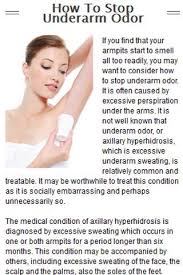
Evaluation:
1. Explain the word ‘Body odour’.
2. Describe five ways of getting rid of body odour during menstrual period.
3. State five causes of body odour.
Reading assignment:
Popoola O.O. Home Economics New Concepts for JSS Book 2 Page 154
Sub-Topic 2: Importance of personal hygiene.
Hygiene is one’s level of cleanliness.
Personal hygiene is the care of a person from head to toe – taking care of the hair, nose, eyes, ear, teeth, hands and feet. As you grow older you continue to maintain good personal hygiene. Ways of maintaining personal hygiene.
1. Have regular baths using clean water and good quality toilet soap.
2. Rub the sponge thoroughly all over the body paying attention to the armpit; under the breast; the pubic area; and the genital organs (male and female)
3. Use a good deodorant under your armpit if you sweet a lot.
4. Keep your clothes clean at all times, especially the underwears.
5. Do not share personal effects like towel, combs, toothbrush, underwear, shaving stick and chewing stick.
6. If you have skin problems like rashes, blemishes, eczema, ringworm and so on, see the doctor or the school nurse immediately.
7. Choose body cream wisely and avoid those that contain bleaching agents.
8. Keep hands and nails clean always. Fingernails should not be kept too long otherwise they will harbor germs.
9. Wash your hands with soap after using the toilet.
10. Avoid touching your nose, mouth and hair unnecessarily.

Importance of personal hygiene
1. Good personal hygiene keeps one from falling ill often.
2. When good personal hygiene is maintained we are at less risk of contacting infections or passing infections to others.
3. Good personal hygiene helps to boost self esteem and confidence, as no one likes to be around people who are untidy.
4. It gives a more attractive appearance.
5. It helps to cope better with temporary skin problems such as pimples, acne, increased perspiration and oily skin.
6. It helps to prevent body odour.
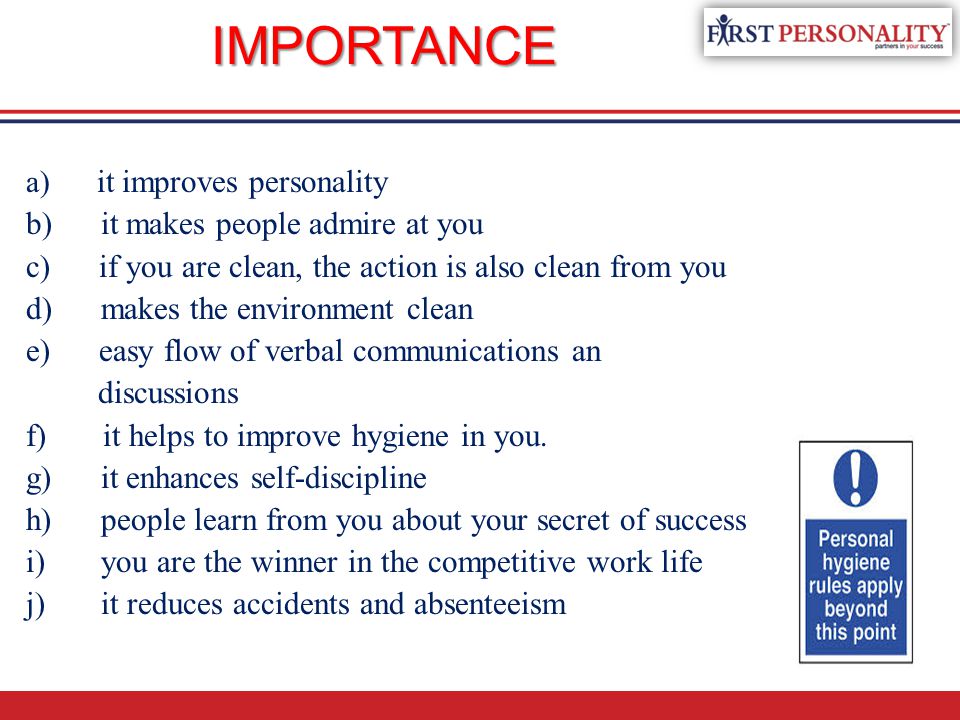
Evaluation:
1. Explain the word ‘Personal Hygiene’.
2. State four ways of maintaining personal hygiene.
3. State four importance of personal hygiene.
Reading assignment:
Popoola O.O. Home Economics New Concepts for JSS Book 2 Pages 154 – 156.
ASSIGNMENT
Popoola O.O. Workbook on Home Economics New Concepts for JSS Book 2 Unit 17 Page 39
CONTENT: 1. Causes and prevention of body odour.
2. Importance of personal hygiene.
Sub-Topic 1: Causes and prevention of body odour
Body odour
A clean body is expected to be odourless. Body odour is therefore an unpleasant smell that comes from the body as a result of poor hygiene.
Deodorants, talcum powder and perfume help to stop body odour but they are no substitute for regular bathing.

Causes of body odour
1. Poor hygiene during menstruation
2. Accumulation of dirt on the body.
3. Stale perspiration
4. Failure to have bath regularly.
5. Wearing dirty clothes.
6. Heavy make-up and perfume.
7. Using of body care products (soaps, creams, perfume etc.) that smell badly.
8. Infections.
9. Not taking proper care of one’s feet.

Importance of personal hygiene.
Body odour can be prevented by:
1. Bath regularly, especially during the menstrual period and after exercises.
2. Observe good hygiene practices.
3. Change your underwear every day.
4. Use good simple deodorants and perfumes.
5. Avoid heavy makeup and perfume.
6. Wear good and clean clothes.
7. Use good soaps to bath such as medicated soap.
8. Do not use perfume to cover unpleasant odour.
9. Apply perfume on clean bodies and clothes.

Evaluation:
1. Explain the word ‘Body odour’.
2. Describe five ways of getting rid of body odour during menstrual period.
3. State five causes of body odour.
Reading assignment:
Popoola O.O. Home Economics New Concepts for JSS Book 2 Page 154
Sub-Topic 2: Importance of personal hygiene.
Hygiene is one’s level of cleanliness.
Personal hygiene is the care of a person from head to toe – taking care of the hair, nose, eyes, ear, teeth, hands and feet. As you grow older you continue to maintain good personal hygiene. Ways of maintaining personal hygiene.
1. Have regular baths using clean water and good quality toilet soap.
2. Rub the sponge thoroughly all over the body paying attention to the armpit; under the breast; the pubic area; and the genital organs (male and female)
3. Use a good deodorant under your armpit if you sweet a lot.
4. Keep your clothes clean at all times, especially the underwears.
5. Do not share personal effects like towel, combs, toothbrush, underwear, shaving stick and chewing stick.
6. If you have skin problems like rashes, blemishes, eczema, ringworm and so on, see the doctor or the school nurse immediately.
7. Choose body cream wisely and avoid those that contain bleaching agents.
8. Keep hands and nails clean always. Fingernails should not be kept too long otherwise they will harbor germs.
9. Wash your hands with soap after using the toilet.
10. Avoid touching your nose, mouth and hair unnecessarily.

Importance of personal hygiene
1. Good personal hygiene keeps one from falling ill often.
2. When good personal hygiene is maintained we are at less risk of contacting infections or passing infections to others.
3. Good personal hygiene helps to boost self esteem and confidence, as no one likes to be around people who are untidy.
4. It gives a more attractive appearance.
5. It helps to cope better with temporary skin problems such as pimples, acne, increased perspiration and oily skin.
6. It helps to prevent body odour.

Evaluation:
1. Explain the word ‘Personal Hygiene’.
2. State four ways of maintaining personal hygiene.
3. State four importance of personal hygiene.
Reading assignment:
Popoola O.O. Home Economics New Concepts for JSS Book 2 Pages 154 – 156.
ASSIGNMENT
Popoola O.O. Workbook on Home Economics New Concepts for JSS Book 2 Unit 17 Page 39
Week 3
TOPIC: ADOLESCENCE
CONTENT: 1. Meaning and characteristics of adolescents.
2. Special needs and challenges of the adolescents.
Sub-Topic 1: Meaning and characteristics of adolescents.
Meaning of adolescence
Adolescence is the period in every person’s life that lies between the end of childhood and the beginning of adulthood. It is a period of time a person matures and moves from childhood to adulthood.
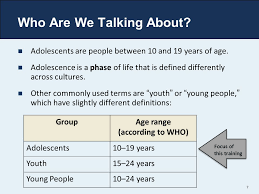
An adolescent is, therefore, defined as a young person, male or female, who is developing into adulthood. This developmental stage can be classified into two:
(a) Early adolescent with age range of 10-13 years.
(b) Late adolescent with age range of 13-20 years.
Characteristics of adolescents.
The adolescent has some characteristics, which can be observed through changes in the physical structure and behaviours or attitudes. Some of these are:
1. Restlessness: Body changes disturb the adolescents emotionally and make them become worried and restless.
2. Tension due to developmental differences: The age of reaching puberty among adolescents varies especially between males and females, some reach puberty early (about 11 years) while some reach very late (about 15 years).
3. Ideas considered as possibilities: Adolescents have opinions and believe that these opinions are the best and only their ideas can work.
4. Search for sophistication: An adolescent wants and likes an ideal life. For instance a girl observes certain changes in herself which make her think that she is matured and therefore, requires some sophistication to enable her cope with the complex environments.
5. Search for independence from adults: All adolescents see themselves as adults and want their own freedom. Many parents do not see the adolescents as capable of handling their affairs by themselves; hence they refuse to grant independence.
6. Search for peer approval: A very strong need of adolescents especially those in school, either male or female, is the acceptance and approval of their behaviour by the age group.
7. Search for correct social order: Observation of adolescents in the high school will reveal that those not properly guided prefer social activities to academic work.
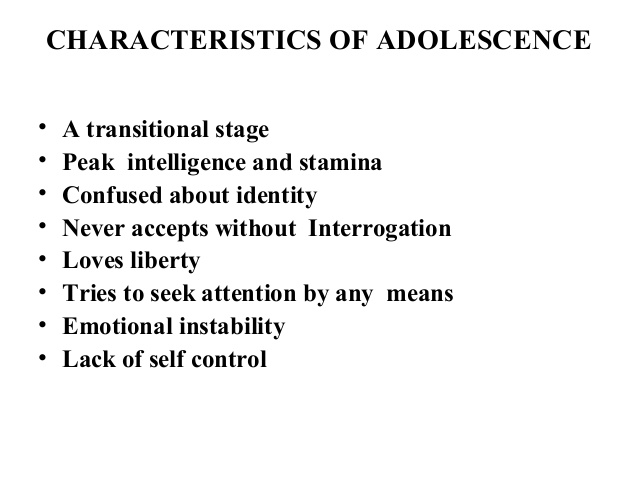
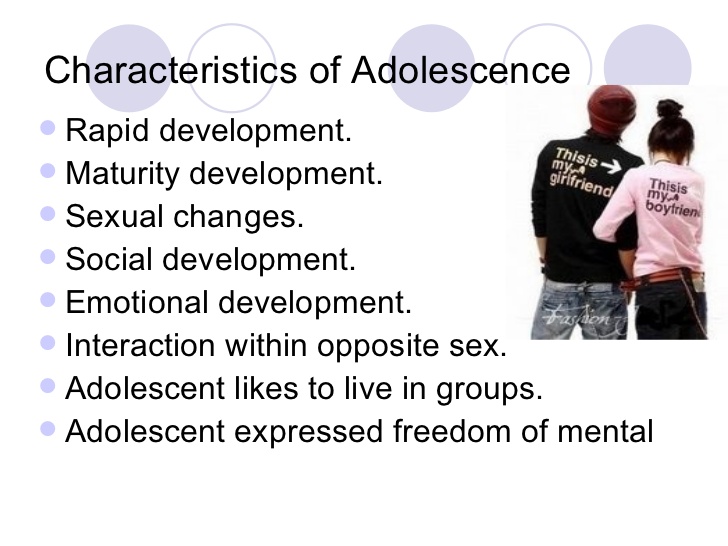
Evaluation:
1. Explain the meaning of adolescence
2. Who is an adolescent?
3. List five characteristics that are common to both adolescent boys and girls.
ACTIVITY
Examine your or your sibling who is an adolescent. What changes can you observe in your / his/her body, moods and behaviour.
Reading assignment:
Popoola O.O. Home Economics New Concepts for JSS Book 2 Page 154
Sub-Topic 2: Special needs and challenges of the adolescents.
The adolescent stage of development can be a turbulent one because the young people concerned are sensitive and are faced with many challenges which they do not want to admit. They tend to live in their own world and want to be left alone. Adults, parents, teachers and guidance counselors must be patient with them and try to understand them.
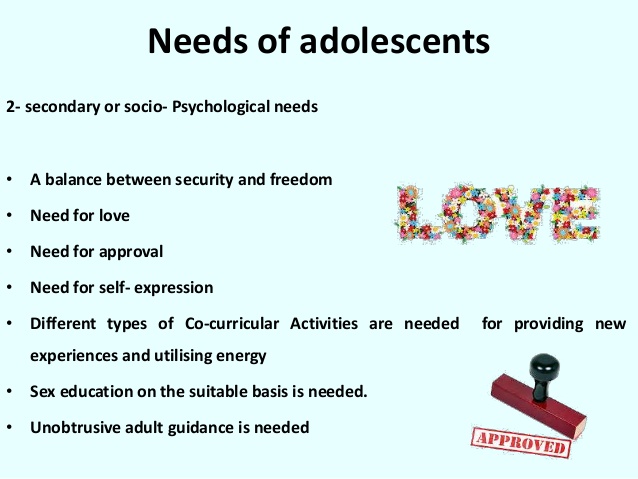
Below are some of the challenges facing the adolescents:
1. Financial problems: some of them come from homes where the parents are poor and cannot afford to meet their needs. At the same time, some rich parents give their children too much money which makes them wasteful.
2. Conflicts: Adults, parents, politicians and the society at large do not set good examples for the youths by engaging in recurrent conflicts.
3. Crime: They can easily fall into bad gangs and turn to robbery, rape and drugs.
4. Unemployment: Many of them are unemployed; therefore, skill acquisition should be emphasized.
5. Peer pressure: They can be easily influenced by their peers, thus the need to constantly counsel them.
6. Poor academic performance: Some of them do not attend school regularly and they cheat during examinations.
7. Some are homeless.
8. Interest in the opposite sex without caution: Some behave irresponsibly because they lack information on sexual education and such relationship may lead to early pregnancies, HIV/AIDS, venereal diseases, etc.
9. Alcoholism: Many adolescents to drink because they derive joy in doing so.
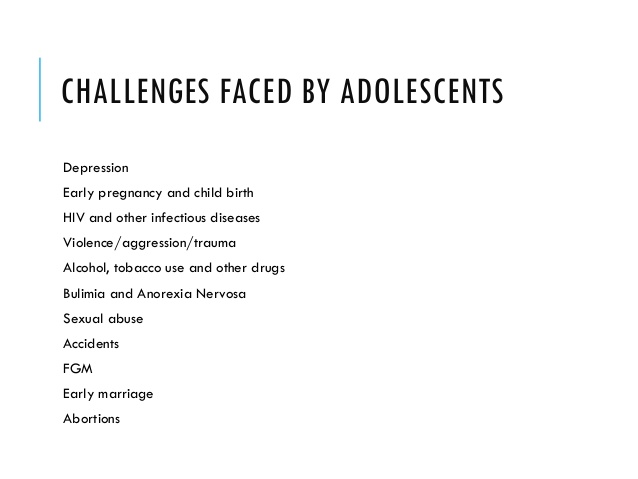
Special needs of the adolescents
1. Food: The adolescents like to eat good and varieties of food. They will want food to be given to them at the right time and in the appropriate quantity.
2. Material needs: They need certain materials (money, clothing items, vehicles, musical and communication equipment) to function well in the society.
3. Education: They want to go to school and become educated. They need education in order to be able to acquire a better social status, work to earn a living and contribute to societal development.
4. Health: They value their health greatly. Parents and guardians should help them have access to medical facilities.
5. Technology: They value electronic gadgets, mobile phones and computers.
6. Persuasion: They do not like to be forced but want to be pampered and convinced
On an issue by their parents or any trusted adults.
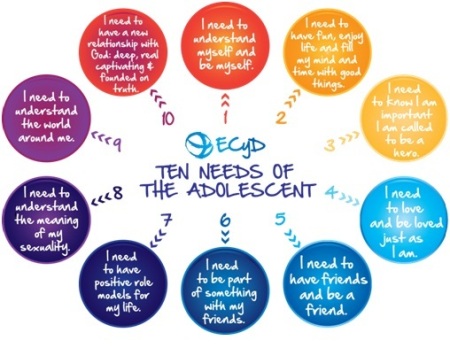
Evaluation:
1. Mention three things adults could do to help adolescent grow and develop as an accepted member of the society.
2. Itemise four special needs of adolescents.
3. State four challenges of adolescents
ACTIVITY
Examine your or your sibling who is an adolescent. What changes can you observe in your / his/her body, moods and behaviour. Write these changes down.
Reading assignment:
Popoola O.O. Home Economics New Concepts for JSS Book 2 Pages 158-160
ASSIGNMENT
Popoola O.O. Workbook on Home Economics New Concepts for JSS Book 2 Unit 17 Page 40
CONTENT: 1. Meaning and characteristics of adolescents.
2. Special needs and challenges of the adolescents.
Sub-Topic 1: Meaning and characteristics of adolescents.
Meaning of adolescence
Adolescence is the period in every person’s life that lies between the end of childhood and the beginning of adulthood. It is a period of time a person matures and moves from childhood to adulthood.

An adolescent is, therefore, defined as a young person, male or female, who is developing into adulthood. This developmental stage can be classified into two:
(a) Early adolescent with age range of 10-13 years.
(b) Late adolescent with age range of 13-20 years.
Characteristics of adolescents.
The adolescent has some characteristics, which can be observed through changes in the physical structure and behaviours or attitudes. Some of these are:
1. Restlessness: Body changes disturb the adolescents emotionally and make them become worried and restless.
2. Tension due to developmental differences: The age of reaching puberty among adolescents varies especially between males and females, some reach puberty early (about 11 years) while some reach very late (about 15 years).
3. Ideas considered as possibilities: Adolescents have opinions and believe that these opinions are the best and only their ideas can work.
4. Search for sophistication: An adolescent wants and likes an ideal life. For instance a girl observes certain changes in herself which make her think that she is matured and therefore, requires some sophistication to enable her cope with the complex environments.
5. Search for independence from adults: All adolescents see themselves as adults and want their own freedom. Many parents do not see the adolescents as capable of handling their affairs by themselves; hence they refuse to grant independence.
6. Search for peer approval: A very strong need of adolescents especially those in school, either male or female, is the acceptance and approval of their behaviour by the age group.
7. Search for correct social order: Observation of adolescents in the high school will reveal that those not properly guided prefer social activities to academic work.


Evaluation:
1. Explain the meaning of adolescence
2. Who is an adolescent?
3. List five characteristics that are common to both adolescent boys and girls.
ACTIVITY
Examine your or your sibling who is an adolescent. What changes can you observe in your / his/her body, moods and behaviour.
Reading assignment:
Popoola O.O. Home Economics New Concepts for JSS Book 2 Page 154
Sub-Topic 2: Special needs and challenges of the adolescents.
The adolescent stage of development can be a turbulent one because the young people concerned are sensitive and are faced with many challenges which they do not want to admit. They tend to live in their own world and want to be left alone. Adults, parents, teachers and guidance counselors must be patient with them and try to understand them.

Below are some of the challenges facing the adolescents:
1. Financial problems: some of them come from homes where the parents are poor and cannot afford to meet their needs. At the same time, some rich parents give their children too much money which makes them wasteful.
2. Conflicts: Adults, parents, politicians and the society at large do not set good examples for the youths by engaging in recurrent conflicts.
3. Crime: They can easily fall into bad gangs and turn to robbery, rape and drugs.
4. Unemployment: Many of them are unemployed; therefore, skill acquisition should be emphasized.
5. Peer pressure: They can be easily influenced by their peers, thus the need to constantly counsel them.
6. Poor academic performance: Some of them do not attend school regularly and they cheat during examinations.
7. Some are homeless.
8. Interest in the opposite sex without caution: Some behave irresponsibly because they lack information on sexual education and such relationship may lead to early pregnancies, HIV/AIDS, venereal diseases, etc.
9. Alcoholism: Many adolescents to drink because they derive joy in doing so.

Special needs of the adolescents
1. Food: The adolescents like to eat good and varieties of food. They will want food to be given to them at the right time and in the appropriate quantity.
2. Material needs: They need certain materials (money, clothing items, vehicles, musical and communication equipment) to function well in the society.
3. Education: They want to go to school and become educated. They need education in order to be able to acquire a better social status, work to earn a living and contribute to societal development.
4. Health: They value their health greatly. Parents and guardians should help them have access to medical facilities.
5. Technology: They value electronic gadgets, mobile phones and computers.
6. Persuasion: They do not like to be forced but want to be pampered and convinced
On an issue by their parents or any trusted adults.

Evaluation:
1. Mention three things adults could do to help adolescent grow and develop as an accepted member of the society.
2. Itemise four special needs of adolescents.
3. State four challenges of adolescents
ACTIVITY
Examine your or your sibling who is an adolescent. What changes can you observe in your / his/her body, moods and behaviour. Write these changes down.
Reading assignment:
Popoola O.O. Home Economics New Concepts for JSS Book 2 Pages 158-160
ASSIGNMENT
Popoola O.O. Workbook on Home Economics New Concepts for JSS Book 2 Unit 17 Page 40
Week 4
TOPIC: Sexuality: meaning and expressions of sexuality, Sources and utilization of sexuality related information e.g. internet and home videos.
Sub Topic 1:
Meaning and expressions of sexuality
Sexuality is defined as the things people think, feel, and do that are related to their sexual desire. Terms related to sexuality include:
(a) Sex: This refers to male or female. It also refers to the physical activity that two people do together to produce babies or for pleasure.
(b) Sexual feeling: This refers to the attraction between male and female.
(c) Sexual intercourse: To have sex with someone

The adolescent boys and girls having reached the stage of puberty, the sex organs, like other parts of the body, are maturing. In girls for example, the breasts are developing to attract the boys. In the boys, the voice is broken and the sexual organs are developing and active. Other body glands are also developing to influence changes in the behaviour of the adolescent boys and girls.
Ways of expressing sexuality by boys and girls
The adolescent boys and girls express sexuality through their behaviour towards the opposite sex. The ways both boys and girls show their sexual thoughts, emotions and attitudes are similar in some aspects, but sometimes vary.
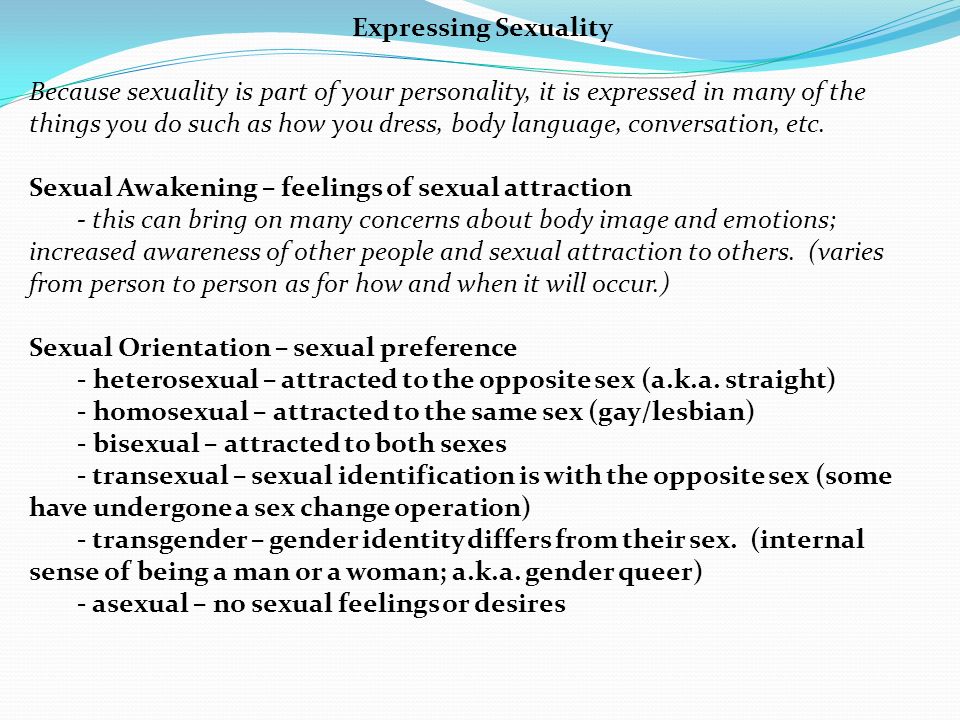
Expression of sexuality by adolescent girls
The adolescent girls express sexuality towards the opposite sex through the following actions:
(a) Dressing: Adolescent girls like attractive fashion. They always want to appeal to the boys’ maturity and interest, not usually in words, but through the mode of dressing. The mode of dressing may take the following forms:
(i) Girls prefer attractive, current, popular and fashionable dresses.
(ii) The colour of the dresses is usually bright to identify the presence of the adolescent girls within a group.
(iii) Earrings, bangles, shoes and rings are worn by girls to make them look beautiful and also a way of expressing their emotions.
(b) Use of cosmetics and deodorants: Adolescent girls make use of sweet-smelling deodorants that can attract the attention of the adolescent boys. The cosmetics are usually applied on the nails, lips, eyelids and eyelashes, etc.
(c) Hair style: There are different hair styles available for the adolescent females that make look attractive to the opposite sex. Such hair styles include, perming, braiding, weaving with various attachments.
(d) Bathing and mouth care: The body of the adolescent is still developing and so the rate of perspiration (sweating) is high and it frequently brings out body odour. Girls usually find it necessary to bath frequently to remove bad odour from the body.
(e) Laundry: This is the process of washing, drying and ironing clothes neatly before wearing. Girls like being attractive to the opposite sex by keeping their dresses clean all the time to avoid bad odour.
(f) Skin care: Females with smooth skin are more easily attracted to the adolescent males than those with rough skin, pimples, rashes and sores. Therefore girls express their desires in the opposite sex by keeping their skin free from pimples, boils, rashes and sores.
(g) Greetings, looks, and smiles: Girls have their own characteristic way of expressing their feelings for the opposite sex without actually talking. They have special looks or facial expression towards attracting boys. For instance, they greet with smiles and inviting looks.
(h) Preference for course of study in higher institution: Adolescent girls are easily attached to the opposite sex who is studying more lucrative and challenging courses such as Medicine, Accountancy, banking and Finance, Engineering, Pharmacy, Architecture, law, etc in the institutions of higher learning.

Expression of sexuality by adolescent boys
The boys express sexuality towards the opposite sex through the following ways:
(a) Body care: Adolescent boys express their emotions towards their female counterparts by taking special care of their body parts such as their hair, face, finger nails and toe nails.
(b) Dressing: The adolescent boys dress in an attract fashion to express their interest in the opposite sex. They like wearing latest clothing like jeans, attractive belts, polo shirts, and fashionable shoes and sandals.
(c) Hobby: Some boys use their hobbies as a means of attracting the opposite sex. They use skills in photography, music and art work. For example, creative art work and beautiful photographs of the girls may be presented to them on their birthdays, graduations days, etc.
(d) Recreation and sports activities: When boys excel in some recreation and sporting activities, their female counterparts are usually attracted by their performance e.g. football.
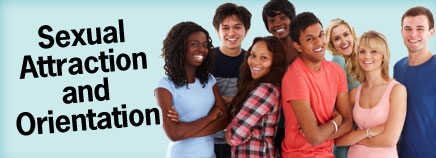
Evaluation:
(1) Define sexuality.
(2) Explain three ways by which a girl can express sexuality.
(3) Explain three ways by which a boy can attract the opposite sex to himself.
Sub-Topic 2:
Sources and utilization of sexuality related information
Boys and girls obtain information on sexuality through the following:
(i) Friends or associates: Most boys and girls are students and they move together in groups, sharing information and stories about sexuality.
(ii) Radio and Television: A lot of information can be obtained from radio and television through programmes that relate to sexuality. Such programmes may include drama, video clips, advertisements, debates, stories, radio talks and interviews.
(III) Magazines: Magazines and other periodicals contain pictures, stories, write-ups and advertisements which can serve as sources of information on sexuality.
(iv) Literature: Students can get information on sexuality from novels written on adventures.
(v) Internet-mail and mobile phones: These are new technologies that make use of the computer. They can provide young boys and girls a variety of information on sexuality.
(vi) Music: Boys and girls value the type of music that appeal to them especially songs that present their feelings towards the opposite sex.
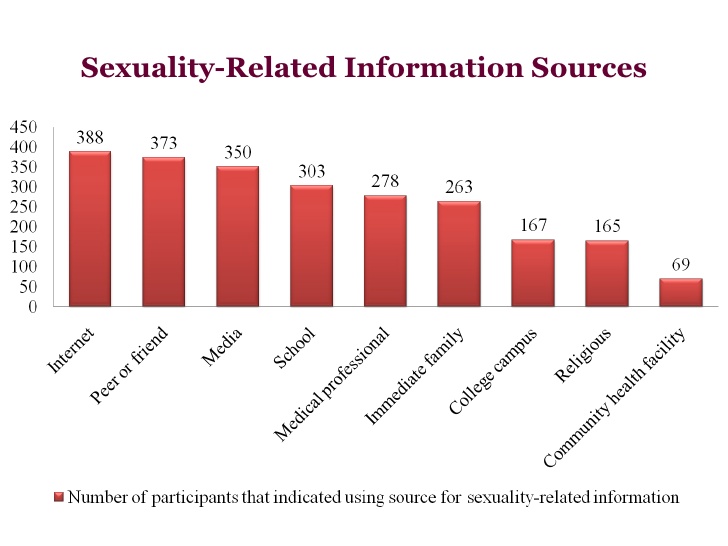
Effects of sexual expression and information on adolescents
Sexual expression and utilization of information by adolescent boys and girls have the following effects on their lifestyles:
(i) It brings about early boy-girl relationship
(ii) It can lead the adolescent boys and girls to early marriage which they are not prepared for.
(iii) It brings about early exposure to sexual relationship
(iv) It leads to unwise spending and lack of planning for the future
(v) It can cause ill health to the adolescent boys and girls through sexually transmitted diseases such as gonorrhea, syphilis and HIV/AIDS.
(vi) Improper information on sexuality can affect the education of the adolescent boys and girls if not well handled. This is because it can lead to truancy, lying and other anti-social behaviours in them.
(vii) It can cause boys’ and girls’ disobedience to parents’ instructions. This may affect the future career and entire life of the adolescents.
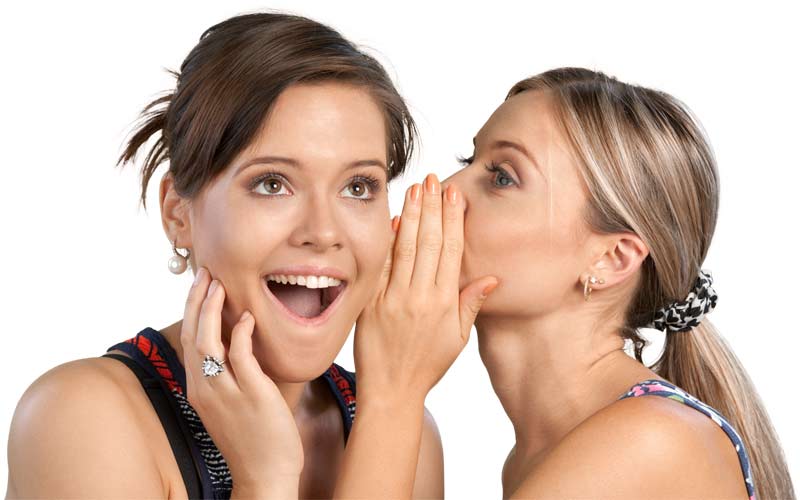
Educating adolescents on sexuality
Adolescent boys and girls can be educated through the following ways:
(i) Sex education should be introduced to the adolescents as early as possible.
(ii) They should be prevented from the habit of keeping pictures of female or male who appear naked or in different sexual postures.
(iii) Both boys and girls should be discouraged from watching films and videos which are sexually immoral.
(iv) Adolescent boys and girls should be educated on how to use the internet, e-mail, face book and mobile phones to obtain educative and academic information.
(v) Boys and girls should be discouraged from over-drinking, smoking and keeping late nights in parties and night clubs.
(vi) Parents should not allow or support intimate relationship between boys and girls who are not old enough or ready to go into marriage.
(vii) Adolescent boys and girls should be educated against drug abuse and its effects on the individual.

Evaluation:
(1) Which of these is Not an effect of early expression of sexuality
(a) Early marriage (b)Dropping out of school (c) Excellence in sports (d) Unwanted pregnancy
(2) Mention three sources of information on sexuality
Assignment:
Identify various ways by which adolescence can be educated on how to use sexual education.
Sub Topic 1:
Meaning and expressions of sexuality
Sexuality is defined as the things people think, feel, and do that are related to their sexual desire. Terms related to sexuality include:
(a) Sex: This refers to male or female. It also refers to the physical activity that two people do together to produce babies or for pleasure.
(b) Sexual feeling: This refers to the attraction between male and female.
(c) Sexual intercourse: To have sex with someone

The adolescent boys and girls having reached the stage of puberty, the sex organs, like other parts of the body, are maturing. In girls for example, the breasts are developing to attract the boys. In the boys, the voice is broken and the sexual organs are developing and active. Other body glands are also developing to influence changes in the behaviour of the adolescent boys and girls.
Ways of expressing sexuality by boys and girls
The adolescent boys and girls express sexuality through their behaviour towards the opposite sex. The ways both boys and girls show their sexual thoughts, emotions and attitudes are similar in some aspects, but sometimes vary.

Expression of sexuality by adolescent girls
The adolescent girls express sexuality towards the opposite sex through the following actions:
(a) Dressing: Adolescent girls like attractive fashion. They always want to appeal to the boys’ maturity and interest, not usually in words, but through the mode of dressing. The mode of dressing may take the following forms:
(i) Girls prefer attractive, current, popular and fashionable dresses.
(ii) The colour of the dresses is usually bright to identify the presence of the adolescent girls within a group.
(iii) Earrings, bangles, shoes and rings are worn by girls to make them look beautiful and also a way of expressing their emotions.
(b) Use of cosmetics and deodorants: Adolescent girls make use of sweet-smelling deodorants that can attract the attention of the adolescent boys. The cosmetics are usually applied on the nails, lips, eyelids and eyelashes, etc.
(c) Hair style: There are different hair styles available for the adolescent females that make look attractive to the opposite sex. Such hair styles include, perming, braiding, weaving with various attachments.
(d) Bathing and mouth care: The body of the adolescent is still developing and so the rate of perspiration (sweating) is high and it frequently brings out body odour. Girls usually find it necessary to bath frequently to remove bad odour from the body.
(e) Laundry: This is the process of washing, drying and ironing clothes neatly before wearing. Girls like being attractive to the opposite sex by keeping their dresses clean all the time to avoid bad odour.
(f) Skin care: Females with smooth skin are more easily attracted to the adolescent males than those with rough skin, pimples, rashes and sores. Therefore girls express their desires in the opposite sex by keeping their skin free from pimples, boils, rashes and sores.
(g) Greetings, looks, and smiles: Girls have their own characteristic way of expressing their feelings for the opposite sex without actually talking. They have special looks or facial expression towards attracting boys. For instance, they greet with smiles and inviting looks.
(h) Preference for course of study in higher institution: Adolescent girls are easily attached to the opposite sex who is studying more lucrative and challenging courses such as Medicine, Accountancy, banking and Finance, Engineering, Pharmacy, Architecture, law, etc in the institutions of higher learning.

Expression of sexuality by adolescent boys
The boys express sexuality towards the opposite sex through the following ways:
(a) Body care: Adolescent boys express their emotions towards their female counterparts by taking special care of their body parts such as their hair, face, finger nails and toe nails.
(b) Dressing: The adolescent boys dress in an attract fashion to express their interest in the opposite sex. They like wearing latest clothing like jeans, attractive belts, polo shirts, and fashionable shoes and sandals.
(c) Hobby: Some boys use their hobbies as a means of attracting the opposite sex. They use skills in photography, music and art work. For example, creative art work and beautiful photographs of the girls may be presented to them on their birthdays, graduations days, etc.
(d) Recreation and sports activities: When boys excel in some recreation and sporting activities, their female counterparts are usually attracted by their performance e.g. football.

Evaluation:
(1) Define sexuality.
(2) Explain three ways by which a girl can express sexuality.
(3) Explain three ways by which a boy can attract the opposite sex to himself.
Sub-Topic 2:
Sources and utilization of sexuality related information
Boys and girls obtain information on sexuality through the following:
(i) Friends or associates: Most boys and girls are students and they move together in groups, sharing information and stories about sexuality.
(ii) Radio and Television: A lot of information can be obtained from radio and television through programmes that relate to sexuality. Such programmes may include drama, video clips, advertisements, debates, stories, radio talks and interviews.
(III) Magazines: Magazines and other periodicals contain pictures, stories, write-ups and advertisements which can serve as sources of information on sexuality.
(iv) Literature: Students can get information on sexuality from novels written on adventures.
(v) Internet-mail and mobile phones: These are new technologies that make use of the computer. They can provide young boys and girls a variety of information on sexuality.
(vi) Music: Boys and girls value the type of music that appeal to them especially songs that present their feelings towards the opposite sex.

Effects of sexual expression and information on adolescents
Sexual expression and utilization of information by adolescent boys and girls have the following effects on their lifestyles:
(i) It brings about early boy-girl relationship
(ii) It can lead the adolescent boys and girls to early marriage which they are not prepared for.
(iii) It brings about early exposure to sexual relationship
(iv) It leads to unwise spending and lack of planning for the future
(v) It can cause ill health to the adolescent boys and girls through sexually transmitted diseases such as gonorrhea, syphilis and HIV/AIDS.
(vi) Improper information on sexuality can affect the education of the adolescent boys and girls if not well handled. This is because it can lead to truancy, lying and other anti-social behaviours in them.
(vii) It can cause boys’ and girls’ disobedience to parents’ instructions. This may affect the future career and entire life of the adolescents.

Educating adolescents on sexuality
Adolescent boys and girls can be educated through the following ways:
(i) Sex education should be introduced to the adolescents as early as possible.
(ii) They should be prevented from the habit of keeping pictures of female or male who appear naked or in different sexual postures.
(iii) Both boys and girls should be discouraged from watching films and videos which are sexually immoral.
(iv) Adolescent boys and girls should be educated on how to use the internet, e-mail, face book and mobile phones to obtain educative and academic information.
(v) Boys and girls should be discouraged from over-drinking, smoking and keeping late nights in parties and night clubs.
(vi) Parents should not allow or support intimate relationship between boys and girls who are not old enough or ready to go into marriage.
(vii) Adolescent boys and girls should be educated against drug abuse and its effects on the individual.

Evaluation:
(1) Which of these is Not an effect of early expression of sexuality
(a) Early marriage (b)Dropping out of school (c) Excellence in sports (d) Unwanted pregnancy
(2) Mention three sources of information on sexuality
Assignment:
Identify various ways by which adolescence can be educated on how to use sexual education.
Week 5
TOPIC: Sexual Transmitted Disease (STDs) and HIV/AIDS: STD/STI, HIV/AIDS- meaning, types, causes, prevention. Management, care and support for infected persons. (b) Consequences of self-medication.
Sub Topic 1:
Meaning, types, causes, prevention, Management.
Sexually transmitted diseases (STDs) or sexually transmitted infections(STI) are diseases spread from one person to another through sexual contact. They are sometimes called venereal diseases.
Types of sexually transmitted diseases
There are many types of sexually transmitted diseases (STDs). These include:
(1) Gonorrhea: This disease is caused by a bacteria called Neisseria gonorrhea. It is spread from an infected person through sexual intercourse.

Symptoms (signs) of sexually transmitted diseases
People infected with gonorrhea show the following symptoms:
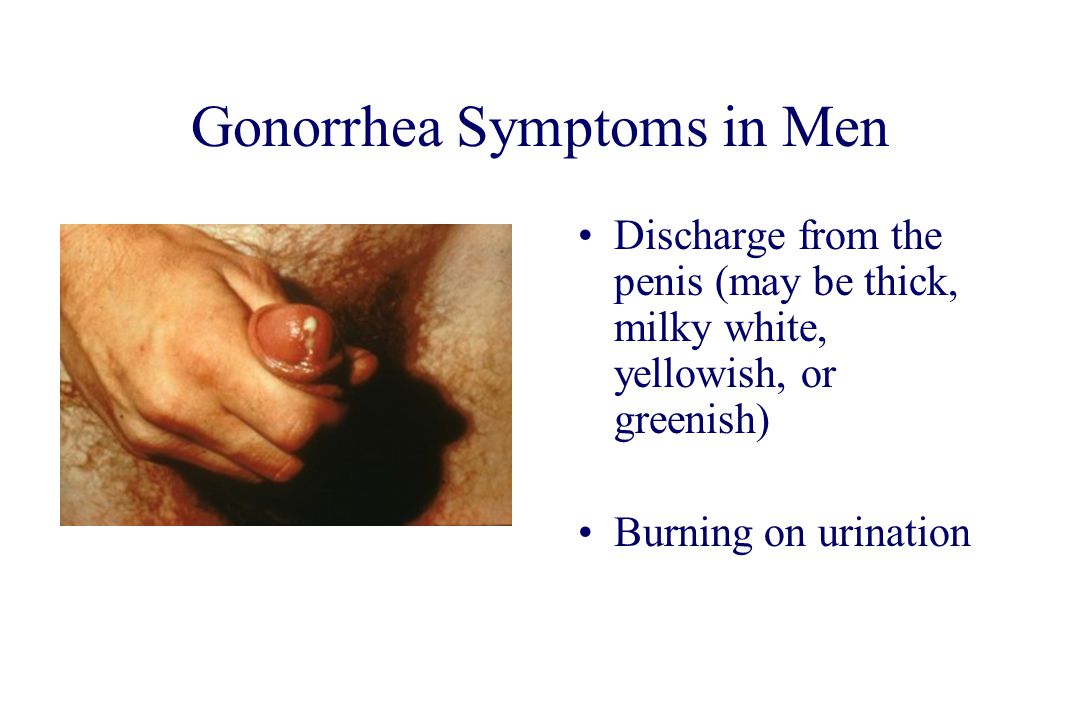
Male infected person
i. There is frequent and very painful urination.
ii. Yellowish discharge from penis
iii. Waist pain
iv. Loss of appetite which leads to loss of weight.
Treatment
This is with the use of antibiotics or see the doctor as the case may be.
Female infected person
i. Frequent urination occurs, but not until a few months after infection.
ii. Smelling mucus from the vagina oozes out of the infected person after a long time.
iii. The patient usually feels pain around her hip.
iv. The patient feels pain in the vulva during sexual intercourse
v. There is loss of appetite and the body temperature is usually high.
vi. The mouth and lips are dry and face looks pale.
vii. The patient is dull and easily irritated.
viii. Advance stage of the infection may lead to wetting of pants with uncommon urination which comes with odour.
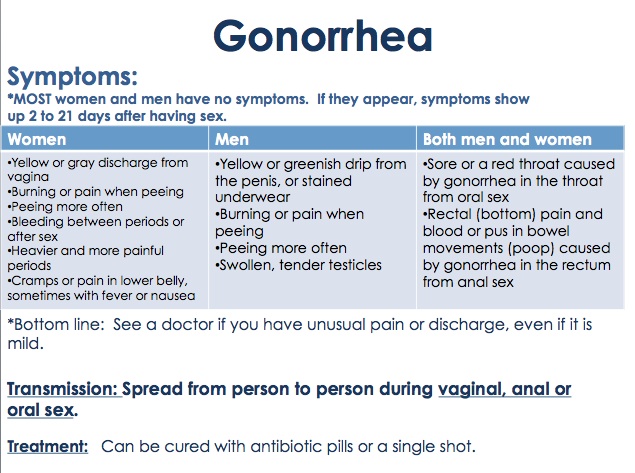
Treatment
The infected person should see a qualified medical doctor.
Prevention and control
Avoid sexual relationship.
(2) Syphilis: This is caused by bacteria called Treponema palladium. It is spread through sexual contact between infected persons.
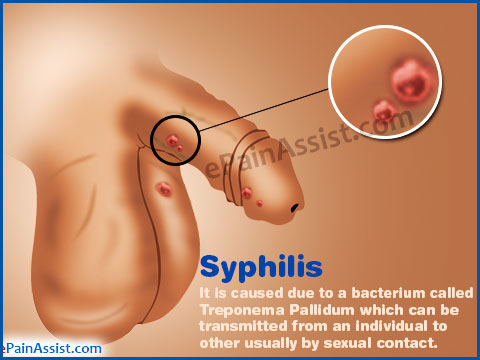
Symptoms (sign) of syphilis
Symptoms of syphilis can be observed in the patient many days after sexual intercourse. That is, it is not easy to detect like that of gonorrhea. The symptoms are as follows:
i. Sores on the sex organs.
ii. Body rashes on palm of hands, soles of feet etc.
iii. Fever, sore throat, hair and weight loss.
iv. Headaches and muscular pains.
v. It may later cause damage to the brain, heart, and eyes.
vi. It can lead to insanity and death.

Treatment
The patient should use antibiotics or see the doctor.
Prevention control
Abstinence i.e. not having sex.
(3) HIV/AIDS: One of the frightening of all STDs is Acquired Immune Deficiency Syndrome (AIDS). It is caused by Human Immune Virus (HIV). HIV is the type of virus which destroys the system and makes it easy for diseases to attack it.HIV can be contracted through the following ways:
i. Sexual intercourse
ii. Blood transfusion
iii. Share of a needle with an HIV/AIDS patient during injection.
iv. Sharing of any sharp object like razor blade, pin with infected person.
v. Blood contact with blood of a person with HIV/AIDS through a cut.
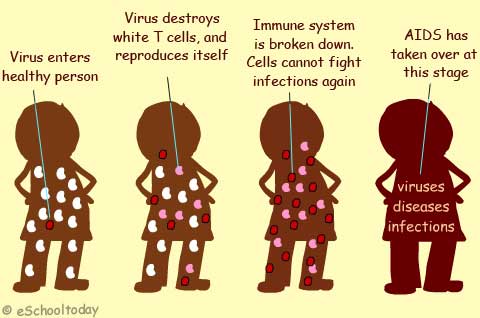
Symptoms of HIV/AIDS
i. The patient has prolonged headache and high temperature with fever.
ii. There is loss of appetite by the patient
iii. The patient usually feels weak for any hard work.
iv. The patient may have bulging stomach and suffer frequent stooling.
v. The patient losses hair on the head.
vi. In some cases the patient coughs frequently.
vii. Some patients develop rashes and boils all over the body.
viii. An HIV/AIDS patient becomes dried up when the infection becomes more pronounced.

A person suffering from full-blown HIV/AIDS
At the moment, there is no known cure for HIV/AIDS. However,
i. Good balanced diet can help reduce the effect of the virus.
ii. The patient needs comfort and counseling from the people around him/her.
iii. Antibiotics and other medicines can help people with HIV/AIDS to feel much better and to live longer.
Evaluation:
1. Explain the meaning of sexually transmitted diseases/infections (STDs/STIs).
2. Which of these is not a sexually transmitted disease/infection?
(a) Gonorrhea (b) syphilis (c) pneumonia (d) HIV/AIDS
3. Mention three symptoms of patients with gonorrhea and three HIV/AIDS.
4. State four way of helping an HIV/AIDS patient to live well.
Sub Topic 1:
Meaning, types, causes, prevention, Management.
Sexually transmitted diseases (STDs) or sexually transmitted infections(STI) are diseases spread from one person to another through sexual contact. They are sometimes called venereal diseases.
Types of sexually transmitted diseases
There are many types of sexually transmitted diseases (STDs). These include:
(1) Gonorrhea: This disease is caused by a bacteria called Neisseria gonorrhea. It is spread from an infected person through sexual intercourse.

Symptoms (signs) of sexually transmitted diseases
People infected with gonorrhea show the following symptoms:

Male infected person
i. There is frequent and very painful urination.
ii. Yellowish discharge from penis
iii. Waist pain
iv. Loss of appetite which leads to loss of weight.
Treatment
This is with the use of antibiotics or see the doctor as the case may be.
Female infected person
i. Frequent urination occurs, but not until a few months after infection.
ii. Smelling mucus from the vagina oozes out of the infected person after a long time.
iii. The patient usually feels pain around her hip.
iv. The patient feels pain in the vulva during sexual intercourse
v. There is loss of appetite and the body temperature is usually high.
vi. The mouth and lips are dry and face looks pale.
vii. The patient is dull and easily irritated.
viii. Advance stage of the infection may lead to wetting of pants with uncommon urination which comes with odour.

Treatment
The infected person should see a qualified medical doctor.
Prevention and control
Avoid sexual relationship.
(2) Syphilis: This is caused by bacteria called Treponema palladium. It is spread through sexual contact between infected persons.

Symptoms (sign) of syphilis
Symptoms of syphilis can be observed in the patient many days after sexual intercourse. That is, it is not easy to detect like that of gonorrhea. The symptoms are as follows:
i. Sores on the sex organs.
ii. Body rashes on palm of hands, soles of feet etc.
iii. Fever, sore throat, hair and weight loss.
iv. Headaches and muscular pains.
v. It may later cause damage to the brain, heart, and eyes.
vi. It can lead to insanity and death.

Treatment
The patient should use antibiotics or see the doctor.
Prevention control
Abstinence i.e. not having sex.
(3) HIV/AIDS: One of the frightening of all STDs is Acquired Immune Deficiency Syndrome (AIDS). It is caused by Human Immune Virus (HIV). HIV is the type of virus which destroys the system and makes it easy for diseases to attack it.HIV can be contracted through the following ways:
i. Sexual intercourse
ii. Blood transfusion
iii. Share of a needle with an HIV/AIDS patient during injection.
iv. Sharing of any sharp object like razor blade, pin with infected person.
v. Blood contact with blood of a person with HIV/AIDS through a cut.

Symptoms of HIV/AIDS
i. The patient has prolonged headache and high temperature with fever.
ii. There is loss of appetite by the patient
iii. The patient usually feels weak for any hard work.
iv. The patient may have bulging stomach and suffer frequent stooling.
v. The patient losses hair on the head.
vi. In some cases the patient coughs frequently.
vii. Some patients develop rashes and boils all over the body.
viii. An HIV/AIDS patient becomes dried up when the infection becomes more pronounced.

A person suffering from full-blown HIV/AIDS
At the moment, there is no known cure for HIV/AIDS. However,
i. Good balanced diet can help reduce the effect of the virus.
ii. The patient needs comfort and counseling from the people around him/her.
iii. Antibiotics and other medicines can help people with HIV/AIDS to feel much better and to live longer.
Evaluation:
1. Explain the meaning of sexually transmitted diseases/infections (STDs/STIs).
2. Which of these is not a sexually transmitted disease/infection?
(a) Gonorrhea (b) syphilis (c) pneumonia (d) HIV/AIDS
3. Mention three symptoms of patients with gonorrhea and three HIV/AIDS.
4. State four way of helping an HIV/AIDS patient to live well.
Week 6
Sub-Topic 2: Guidelines for caring for people with HIV/AIDS and Consequences of self- medication.
Guidelines for caring for people with HIV/AIDS
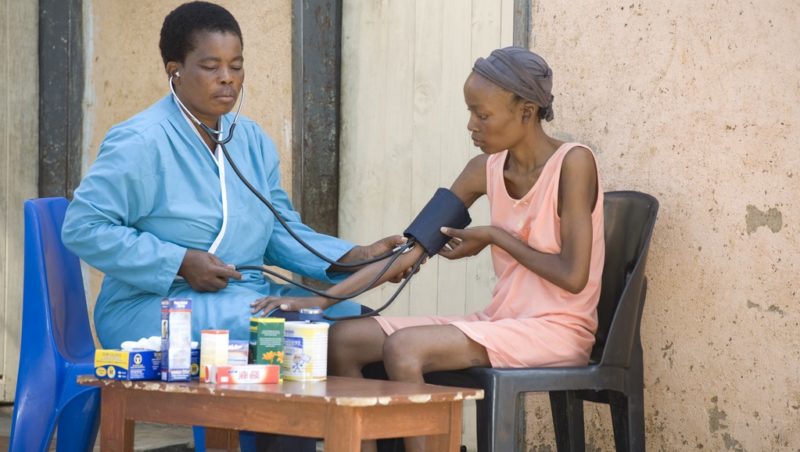
The following guidelines are helpful in caring for an HIV/AIDS patient:
(1) Provide a home where there is peace, rest, love and acceptance.
(2) Help them with household work so that they can have time to rest.
(3) Make them eat nutritious food
(4) Give them love and support.
(5) Share their financial burden.
(6) Wash their clothes and sheet.
(7) Pay them regular visits.
(8) Nurse them.
Self-medication.
Self medication is the process where a person prescribes drugs for self, or gets someone else other than a qualified professional to do so when he/she is sick.

Consequences of self medication: These include:
1. A person’s self diagnosis of illness might be wrong. So you may buy the wrong drug for an illness.
2. Over dose of drugs can weaken or destroy some organs and tissues in the human body.
3. It can prolong the cure of some diseases.
4. It can cause complications of the disease being treated.
5. It leads to drug abuse/misuse.
6. It leads to death.
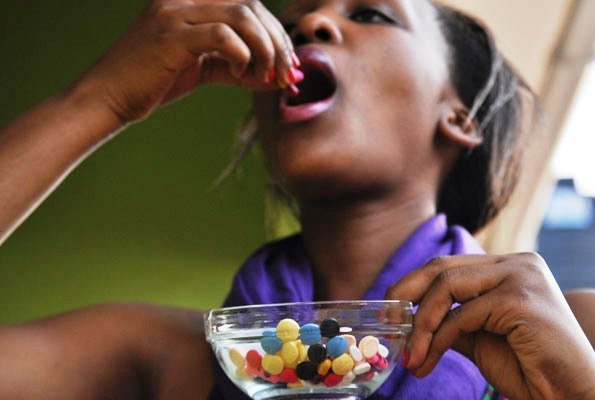
[youtube]https://www.youtube.com/watch?v=LySAITjPNHA[/youtube]
Evaluation:
1. What is self medication?
2. State any four consequences of self medication.
Assignment:
Work book on Home Economics New Concepts for Nigerian Jnr. Secondary Schools. Pgs. 41-42.
Guidelines for caring for people with HIV/AIDS

The following guidelines are helpful in caring for an HIV/AIDS patient:
(1) Provide a home where there is peace, rest, love and acceptance.
(2) Help them with household work so that they can have time to rest.
(3) Make them eat nutritious food
(4) Give them love and support.
(5) Share their financial burden.
(6) Wash their clothes and sheet.
(7) Pay them regular visits.
(8) Nurse them.
Self-medication.
Self medication is the process where a person prescribes drugs for self, or gets someone else other than a qualified professional to do so when he/she is sick.

Consequences of self medication: These include:
1. A person’s self diagnosis of illness might be wrong. So you may buy the wrong drug for an illness.
2. Over dose of drugs can weaken or destroy some organs and tissues in the human body.
3. It can prolong the cure of some diseases.
4. It can cause complications of the disease being treated.
5. It leads to drug abuse/misuse.
6. It leads to death.

[youtube]https://www.youtube.com/watch?v=LySAITjPNHA[/youtube]
Evaluation:
1. What is self medication?
2. State any four consequences of self medication.
Assignment:
Work book on Home Economics New Concepts for Nigerian Jnr. Secondary Schools. Pgs. 41-42.
Week 7
TOPIC: The impact of family values on life styles: Family values and life style- (i) Meaning of values and life styles, (ii) Types of values and life styles.
Sub-Topic 1:
Meaning of values and life styles
Value is the worth placed on an item. It can be defined as the moral standard of behaviour that a family or an individual lives. They include: beliefs, feelings, or ideas of what is important, desirable and good.
Life style is the particular way of life of a person or a family or a nation. It is clear and concise view of the kind of living that will bring satisfaction to a person, group, or family and to other people necessary to make that life style satisfactory.
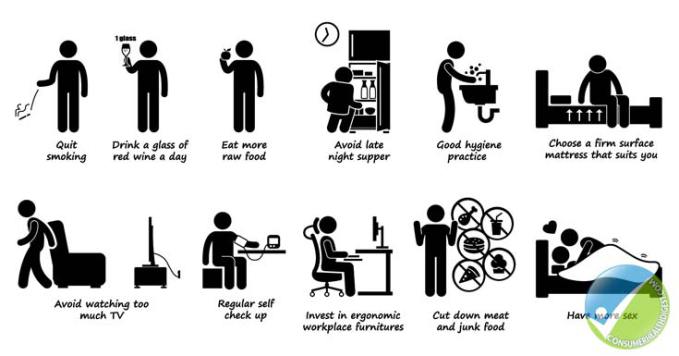
Evaluation:
(1) Explain the meaning of values and life style.
(2) One of the following is not a life style of somebody who values money too much. (a) pride (b)aggression (c) simplicity (d)stinginess
Sub-Topic 2:
Types of values and life styles.
Types of values
(1) Intrinsic value: These are values that are important for their own sake. Examples of intrinsic values are love, aesthetics, freedom, truth, human dignity, etc.
(2) Instrumental values: These are values that help to achieve the intrinsic or high values. Examples are orderliness and efficiency which can help to achieve aesthetic value in your home. Others are convenience, hard work, leisure, companionship, etc.
(3) Values that have intrinsic and instrumental worth: These are important for their own sake and can help you in achieving the higher values. Examples are comfort, health, knowledge, religion, ambition, art, trust, honesty.
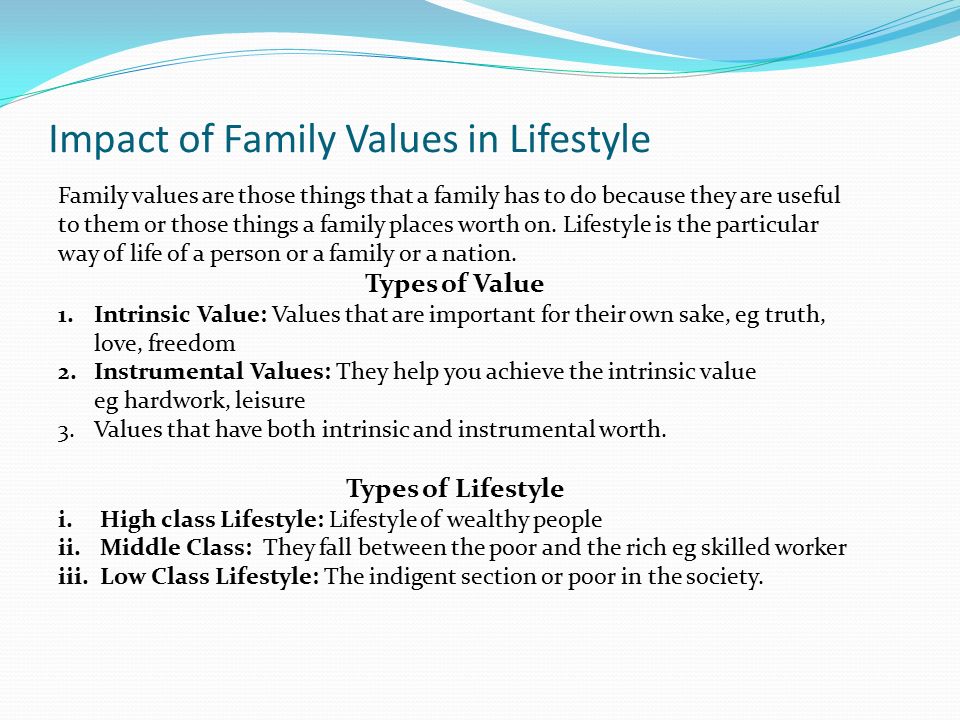
Types of life style
There are different ways of classifying life styles. Life styles are made of ways of life of a person or group. It can be classified based on:
i. Roles and roles combination: e.g. employers and employees, parents, spouse, student. Each may have different ways of life. The ways are based on the roles performed by each person.
ii. Consumer practices: some people may be conspicuous consumers, others may be moderate.
iii. Occupation and employment patterns: A person’s occupation and employment pattern will normally influence how he/she does a thing. For instance, bankers, lawyers, doctors, teachers, judges, business people, all have different life styles as a result of their profession.

Evaluation:
1. List the three classes of values and give one example of each.
2. One’s life style is based, list and explain three of them.

Assignment:
Work book on Home Economics New Concepts for Nigerian Jnr. Secondary Schools. Pgs.17-18.
Activity
Identify your most important personal values. Write down 10 ways in which these values have influenced your actions.
Sub-Topic 1:
Meaning of values and life styles
Value is the worth placed on an item. It can be defined as the moral standard of behaviour that a family or an individual lives. They include: beliefs, feelings, or ideas of what is important, desirable and good.
Life style is the particular way of life of a person or a family or a nation. It is clear and concise view of the kind of living that will bring satisfaction to a person, group, or family and to other people necessary to make that life style satisfactory.

Evaluation:
(1) Explain the meaning of values and life style.
(2) One of the following is not a life style of somebody who values money too much. (a) pride (b)aggression (c) simplicity (d)stinginess
Sub-Topic 2:
Types of values and life styles.
Types of values
(1) Intrinsic value: These are values that are important for their own sake. Examples of intrinsic values are love, aesthetics, freedom, truth, human dignity, etc.
(2) Instrumental values: These are values that help to achieve the intrinsic or high values. Examples are orderliness and efficiency which can help to achieve aesthetic value in your home. Others are convenience, hard work, leisure, companionship, etc.
(3) Values that have intrinsic and instrumental worth: These are important for their own sake and can help you in achieving the higher values. Examples are comfort, health, knowledge, religion, ambition, art, trust, honesty.

Types of life style
There are different ways of classifying life styles. Life styles are made of ways of life of a person or group. It can be classified based on:
i. Roles and roles combination: e.g. employers and employees, parents, spouse, student. Each may have different ways of life. The ways are based on the roles performed by each person.
ii. Consumer practices: some people may be conspicuous consumers, others may be moderate.
iii. Occupation and employment patterns: A person’s occupation and employment pattern will normally influence how he/she does a thing. For instance, bankers, lawyers, doctors, teachers, judges, business people, all have different life styles as a result of their profession.

Evaluation:
1. List the three classes of values and give one example of each.
2. One’s life style is based, list and explain three of them.

Assignment:
Work book on Home Economics New Concepts for Nigerian Jnr. Secondary Schools. Pgs.17-18.
Activity
Identify your most important personal values. Write down 10 ways in which these values have influenced your actions.
Week 8
TOPIC: The impact of family values on life styles: (iii) importance of value systems and life styles (iv) factors that influence individual, family, and societal values and life styles.
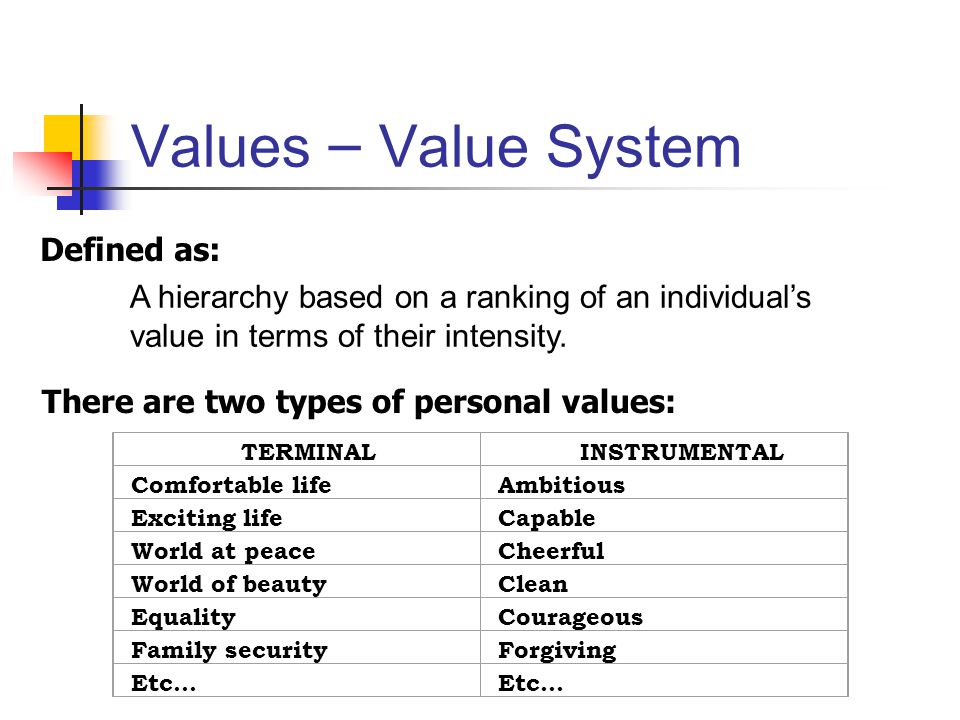
Sub-Topic 1:
Importance of value systems and life styles
To the individual
Your value system is made of the set of values you have. It is important to you in the following ways:
i. A value system helps you make decisions.
ii. Values provide motivation. For instance, if you value education, you study to pass your examination instead of attending parties.
iii. Values control your behaviour.
iv. Clear values provide confidence and strength. For instance when confusion arises in your life, your values can help you to resolve issues.
v. Positive values help you to focus on others, not just yourself.
vi. Your value system influences your life styles.
vii. It also determines the type and levels of goals you set for yourself.
viii. Values bring consistency to your outlook and actions. i.e., you will not be easily influenced by other people.
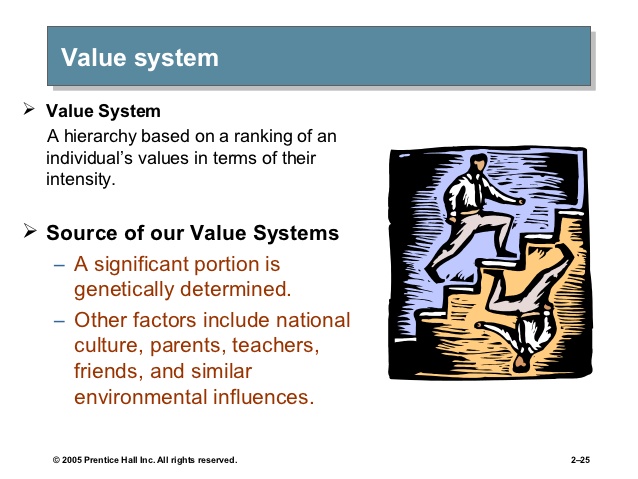
To the family
The family value system is a set of values that the family has. It:
i. Determines the quality of life and life style of the family.
ii. Determines the type of goals the family sets. For instance a family that values education sets high education for their children.
iii. Influences family decisions.
iv. Determines how families use their resources.
v. Helps family to decide the nature and effect of outside influences.
vi. Influences the behaviour of family members within and outside the family.
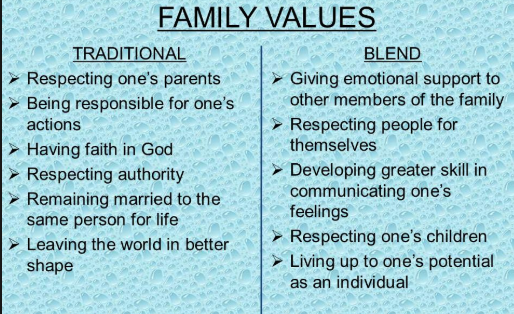
To the society
The value systems of a society are those values which societies have accepted as right for all members. Many of these values are written down in documents and laws e.g. freedom for all, education for all. Some of the values of Nigeria as a nation are national unity, human dignity, dignity of labour, equality of opportunity, accountability,etc. such value system is important to the society because it helps the society to:
i. Make decisions about resources allocation
ii. Develop various areas of importance or economy e.g. health education, commerce and industry.
iii. Provide for every member of the society
iv. Plan good behaviour code members.
v. Plan and provide good programmes for the citizens.
vi. Prevent evil practices in the country.
vii. Solve problems in the country.
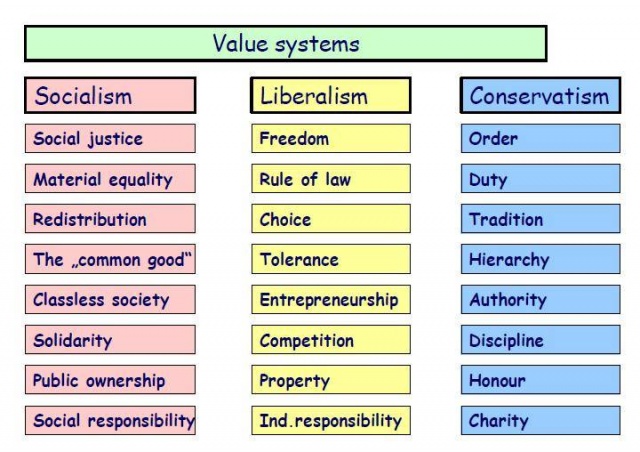
Evaluation:
What is the importance of value system to?
i. The individual
ii. The family
iii. The society
Sub-Topic 2:
Factors that influence individual, family, and societal values and life styles.
Values can be learned. They also change with time. Some of the following factors can affect the values you learn and those you change.
i. Family: your family, parents, siblings, uncles, aunties, cousins, grandparents
ii. Education: what you learn in school, your teacher and school mates.
iii. Older persons who serve as examples.
iv. Movies, television, books, magazines, newspapers all suggest different types of values.
v. Neighbours and community contacts.
vi. Religion trainings.
vii. Happening in the society e.g. violence, conflicts, cult activities
viii. Internet.
Family value system impacts on the family’s life styles in many ways. For instance:
i. Family values influence the decisions made by the family on the use of their resources
ii. It is based on values that families decide to adopt a particular life style or way of living.
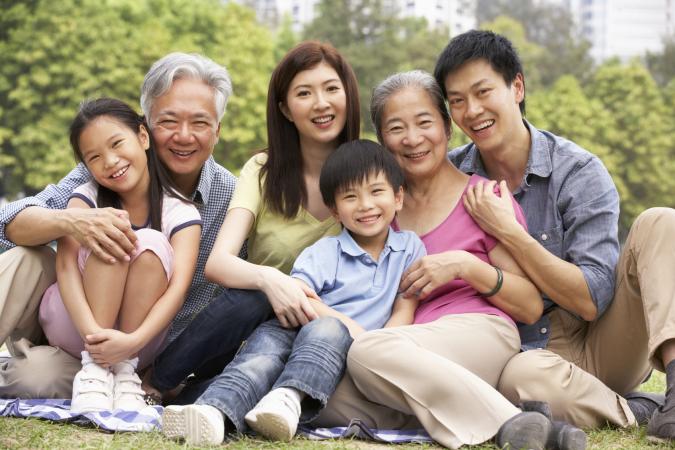
Evaluation:
Identify 10 factors that influences family values
Assignment:
Describe the ways family value system impacts on life styles.

Sub-Topic 1:
Importance of value systems and life styles
To the individual
Your value system is made of the set of values you have. It is important to you in the following ways:
i. A value system helps you make decisions.
ii. Values provide motivation. For instance, if you value education, you study to pass your examination instead of attending parties.
iii. Values control your behaviour.
iv. Clear values provide confidence and strength. For instance when confusion arises in your life, your values can help you to resolve issues.
v. Positive values help you to focus on others, not just yourself.
vi. Your value system influences your life styles.
vii. It also determines the type and levels of goals you set for yourself.
viii. Values bring consistency to your outlook and actions. i.e., you will not be easily influenced by other people.

To the family
The family value system is a set of values that the family has. It:
i. Determines the quality of life and life style of the family.
ii. Determines the type of goals the family sets. For instance a family that values education sets high education for their children.
iii. Influences family decisions.
iv. Determines how families use their resources.
v. Helps family to decide the nature and effect of outside influences.
vi. Influences the behaviour of family members within and outside the family.

To the society
The value systems of a society are those values which societies have accepted as right for all members. Many of these values are written down in documents and laws e.g. freedom for all, education for all. Some of the values of Nigeria as a nation are national unity, human dignity, dignity of labour, equality of opportunity, accountability,etc. such value system is important to the society because it helps the society to:
i. Make decisions about resources allocation
ii. Develop various areas of importance or economy e.g. health education, commerce and industry.
iii. Provide for every member of the society
iv. Plan good behaviour code members.
v. Plan and provide good programmes for the citizens.
vi. Prevent evil practices in the country.
vii. Solve problems in the country.

Evaluation:
What is the importance of value system to?
i. The individual
ii. The family
iii. The society
Sub-Topic 2:
Factors that influence individual, family, and societal values and life styles.
Values can be learned. They also change with time. Some of the following factors can affect the values you learn and those you change.
i. Family: your family, parents, siblings, uncles, aunties, cousins, grandparents
ii. Education: what you learn in school, your teacher and school mates.
iii. Older persons who serve as examples.
iv. Movies, television, books, magazines, newspapers all suggest different types of values.
v. Neighbours and community contacts.
vi. Religion trainings.
vii. Happening in the society e.g. violence, conflicts, cult activities
viii. Internet.
Family value system impacts on the family’s life styles in many ways. For instance:
i. Family values influence the decisions made by the family on the use of their resources
ii. It is based on values that families decide to adopt a particular life style or way of living.

Evaluation:
Identify 10 factors that influences family values
Assignment:
Describe the ways family value system impacts on life styles.
